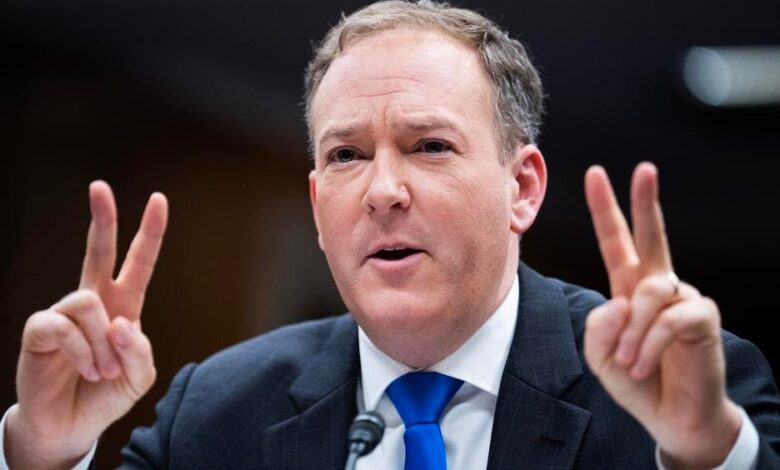EPA Turns A Blind Eye

📝 usncan Note: EPA Turns A Blind Eye
Disclaimer: This content has been prepared based on currently trending topics to increase your awareness.
UNITED STATES – MAY 14: EPA Administrator Lee Zeldin testifies during the Senate Appropriations Subcommittee on Interior, Environment, and Related Agencies hearing titled “A Review of the President’s FY2026 Budget Request for the Environmental Protection Agency,” in Dirksen on Wednesday, May 14, 2025. (Tom Williams/CQ-Roll Call, Inc via Getty Images)
CQ-Roll Call, Inc via Getty Images
Last month, the Trump administration announced that greenhouse gases are no longer a threat to human health. By canceling the 2009 “Endangerment Finding,”1 the administration is defying a 2007 Supreme Court ruling that allowed the EPA to regulate greenhouse gases as pollutants. The administration is also turning a blind eye to the economic and health costs of climate change–all while the science proving these economic and health impacts is advancing exponentially. And in a threat to fossil fuel companies and their government allies, that science is being used in courts in a growing number of legal actions against the world’s largest greenhouse gas emitters.
Attribution Science: Pinpointing companies’ liability for weather-related disasters
In canceling the Endangerment Finding, the administration is denying the fast developing field of “attribution science.” Attribution science uses data such as satellite weather observations, alongside advances in climate models, to calculate the link between specific greenhouse gas emitters and economic and health damages. For example, a study published in Nature calculated that the global economy would be $28 trillion richer were it not for the extreme heat caused by the emissions of the largest oil and gas companies. Attribution science and related scientific advances also prove that EPA Administrator Lee Zeldin is simply wrong when he cites strangling of the US economy as the reason for repealing the Endangerment Finding. EPA claims that, by throwing out all greenhouse gas standards, canceling the Endangerment Finding will save Americans $54 billion annually. Yet in June 2025, before EPA issued its Endangerment Finding ruling, scientists at the University of MD estimated $1.1 trillion in losses between now and 2030 in US GDP due to the reversal of clean energy policies. State-level GDP will also be reduced by up to 5%, with Texas, Michigan, Indiana, Montana, Alaska, Wyoming, and Vermont suffering the highest losses. This is not to mention a $206 rise in average home energy costs, and thousands of deaths due to increased pollution, extreme heat, and other climate-caused disasters.
Attribution science has advanced to the point where we can pinpoint the contribution of any one large greenhouse gas emitter, like Saudi Aramco or Chevron, to the risk of a specific disaster occurring. It also allows us to calculate how much larger an event–like a flood or heat wave–was because of a specific company’s greenhouse gas emissions.
Attribution Science is Being Used in Court
These scientific advances are increasingly being used in civil suits against energy companies and governments. In a case decided earlier this year, Luciano Lliuya, a farmer who lives in the Peruvian Andes, sued German energy giant RWE. Because attribution science showed that the company’s emissions contributed 0.47% of total climate warming, Lliuya asked RWE to pay 0.47% of the costs of a dam to alleviate the risk of melting glaciers causing a flood that would devastate his community. The European Court dismissed the case based on the fact that the flood had not yet occurred. But, in what is seen as a harbinger for success of future lawsuits, the court ruled that large emitters can be held responsible for the consequences of their greenhouse gas emissions. According to Joana Setzer and Catherine Higham of the Grantham Research Institute on Climate Change and the Environment, while the Court ultimately dismissed the individual claim, it “confirmed a powerful legal principle: companies can, in principle, be held legally liable for the harm caused by their contribution to climate change.”
The Lliuya-RWE case is only one of a growing number of cases being brought against governments and private companies. Other US cases relying on attribution science currently under litigation include a state court lawsuit in which Multnomah County OR is seeking over $1.5 billion in damages from energy companies for their role in the harms caused by the 2021 heatwave. And in Puerto Rico municipalities filed lawsuits against fossil fuel companies for their part in aggravating the impacts of Hurricanes Maria and Irma. In yet another example, cities in southern CA are citing attribution science in cases filed for damages due to sea level rise and extreme storms.
Attribution science means that such lawsuits are increasingly likely to succeed. The impact of these lawsuits goes beyond the courtroom to include shifting public opinion about government inaction and fossil fuel liability, stronger climate legislation, and reputational and financial harm for fossil fuel firms. Recently, nearly half of cases heard by courts globally have resulted in more ambitious action on climate. However, to truly achieve the emissions reductions needed to prevent the choking smoke from Canadian wildfires blanketing much of the US, or the dramatic increase in heat-related deaths to over 2300 in the US in 2023, or the floods killing children and families in Texas, North Carolina, and elsewhere, faster and stronger legislative and executive action to limit emissions–not running away from existing laws–is needed.
Climate Superfund Laws in VT and NY Cite Attribution Science
Attribution science is also being used in Climate Superfund laws passed in VT and NY, with similar bills being considered in CA, MD, and MA. The New York bill, which was signed into law in December 2024, specifies $75 billion in damages from fossil fuel companies, with each company’s share based on their share of emissions. According to the bill: “Based on decades of research it is now possible to determine with great accuracy the share of carbon dioxide released into the atmosphere by specific fossil fuel companies over the last 70 years or more, making it possible to assign liability to and require compensation from companies commensurate with their emission of carbon dioxide into the atmosphere during a given time period.”
Reckless Denial and Homicide
In reaction to the growing number of deaths caused by climate disasters, legal scholars from Public Citizen recently laid out the argument for bringing homicide charges against fossil fuel companies. Focusing on the 2023 Arizona heat wave, the lawyers’ argument starts by using health department records to show that the deaths of victims were caused by the 2023 heat wave. Next, they use climate attribution studies to show that the 2023 heat wave would have been “virtually impossible” but for human-caused climate change. Third, they point out how fossil fuel companies have generated a substantial portion of the greenhouse gas emissions that have caused the planet to heat up. Finally, the legal scholars draw on internal company memos proving that the fossil fuel industry was well aware that atmospheric CO2 could do “great irreversible harm to our planet,” and that resultant warming can “have serious consequences for man’s comfort and survival since patterns of aridity and rainfall can change, the height of the sea level can increase considerably and the world food supply can be affected.” Yet, the companies acted recklessly by publicly sowing doubt about the very same science they were discussing internally. Based on a vast body of company internal documents, the legal scholars conclude that the fossil fuel industry acted recklessly, and thus had a “culpable mental state.” In short, “the lethality of fossil fuel companies’ conduct, their awareness of the risks they are generating, and their efforts to obscure those risks make criminal prosecution for homicide particularly appropriate.”
Reckless Repeal of the Endangerment Finding
Just as the fossil fuel industry acted recklessly in ignoring their own science, the current administration is seeking a reckless repeal of established climate science, including attribution science. How might this repeal impact plaintiffs in current and future climate litigation against greenhouse gas emitters? Although cases may still proceed, the EPA ruling will undoubtedly aid the fossil fuel defendants in arguing against their own and established science. I wonder: How much longer can the current administration and cutting-edge science race in opposite directions?
FOOTNOTE
1 The Endangerment Finding is the first step required by the Clean Air Act for EPA to regulate a pollutant. In the Mass v EPA (2007) case, the Supreme Court affirmed that if EPA found that greenhouse gas emissions (GHGs) endanger public health and welfare, then EPA could regulate GHGs as a “pollutant.” The Endangerment Finding adopted by Obama’s EPA in 2009 establishes the statutory foundation for regulating six GHGs that EPA listed as pollutants: CO2, N2O (nitrous oxide), CH4 (methane), HFCs, PFCs and SF6. If the Endangerment Finding is withdrawn, there will be no statutory predicate for regulating these GHGs as pollutants. EPA has also adopted regulatory programs for CO2 from power plants and motor vehicles, and methane from oil and gas production and storage. Statutory authority for these programs will no longer exist if the Endangerment Finding is withdrawn. Trump’s goal, as he promised the industry during the campaign, is to protect oil, gas and coal producers from regulations that will take away their dominance over energy production in the US.




